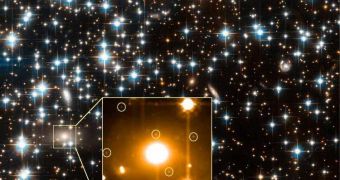There's a reason why the Hubble telescope was placed in orbit around Earth, and it's a pretty good one too. The lack of any interference from the planet's atmosphere allows it to see objects that modern ground-based telescopes probably never will - such as a newly discovered galaxy that seems to be filled with star clusters, some of the oldest structures in the visible universe. No sooner was the discovery made than astronomers got themselves into a new mystery: the clusters in this particular galaxy are redder than expected.
The galaxy that houses our solar system, the Milky Way, is thought to contain at least 158 different star clusters, while the newly found elliptical galaxy, some 1.2 billion light years away, displays no less than 195 clusters and at least another several thousand which are too faint to see even with the Hubble Space Telescope.
"If it was any farther, we wouldn't have seen it. The globular clusters would have been too faint," said Jason Kalirai of the University of California, a member of the team detailing the new discovery.
Preliminary estimates put the age of the galaxy close to that of the Milky Way, which means it is about 12 billion years old, thus its age and relative distance to our own galaxy make this particular object an interesting subject of investigation, having the potential to reveal some interesting facts about the life of stars in a much earlier stage of development.
Basically, the light emitted by the stars inside the new galaxy needed 1.2 billion years to reach Earth, thus it is only logical to believe that the stars would appear younger and more massive, thus bluer, while typical older stars are generally redder. The same should apply to the stars in the galaxy found by Hubble, albeit astronomers discovered that they are in fact 20 percent redder than previously expected.
"The evolution of stars doesn't happen real fast late in life - it's sort of like watching the changes between a 60- and a 65-year-old. They're not as spectacular as the changes between birth and the first 5 years of life," says astronomer Stephen Zepf of Michigan State University, who wasn't part of the research team.
Although the team cannot account for this unusual discovery yet, Kalirai believes that it may be related to the chemical composition of the observed stars or it may be the result of incorrect stellar models, which have been used to approximate the rate at which these stars pass through different life stages and how their metallicity content changes during the nuclear fusion reactions.
"It's possible there's something about stellar evolution we don't understand. The authors make the best correction possible, but it's still an uncertainty. It's the explanation that requires the least amount of changes," says Zepf, while pointing out that the effect could also be generated by the presence of blue light absorbing matter in our line of sight, making the galaxy appear redder than it actually is.
The discovery of individual star clusters in distant galaxies is no longer something out of the ordinary, although most of the observed galaxies are usually too far away to make detailed measurements such as those related to their redness. What's even more frustrating is that the discovery of similar distant galaxies containing star clusters is highly improbable, mostly because they are so dim, some 500 times fainter than the human eye can see.
"It's very interesting, it's just unfortunate. They give us a glimpse of what has happened in the past, but only a glimpse," said Kalirai.

 14 DAY TRIAL //
14 DAY TRIAL //